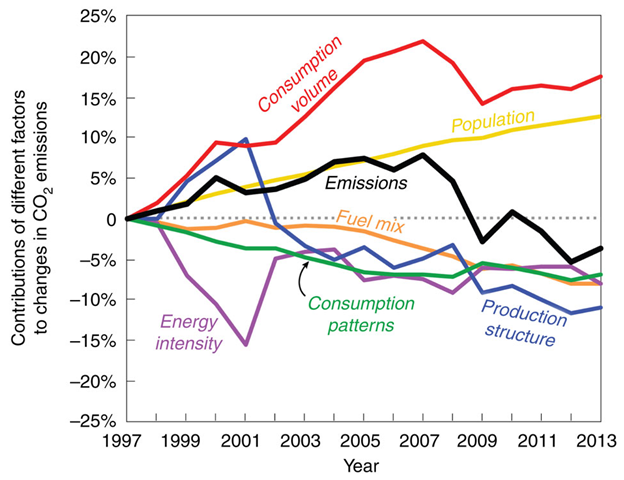Recession rather than shale gas caused US carbon cuts: study – ‘Substitution of gas for coal has had a relatively minor role’
By Simon Evans
21 July 2015 (Carbon Brief) – It is a truth almost universally acknowledged that the shale gas revolution has led to a fall in US emissions. But what if that wasn’t true? New research published in Nature Communications suggests it was the global financial crisis, not fracking, that has done most to reduce carbon dioxide (CO2) emissions from the US. The paper concludes:“After 2007, decreasing emissions were largely a result of economic recession … substitution of gas for coal has had a relatively minor role.”
Carbon Brief looks at the findings, and why they could be politically significant.
Conventional wisdom
The idea that shale gas has been behind US emissions reductions is repeated in news coverage, speeches and reports. It is used by gas advocates making the case for fracking in the UK. It has entered the political consciousness and is widely accepted as fact. This conventional wisdom runs to the highest levels of scientific analysis. In its latest assessment report the Intergovernmental Panel on Climate Change says fracking is “an important reason for a reduction of greenhouse gas emissions in the United States”. […]
Sizing shale’s influence
Using an approach called structural decomposition analysis, the researchers attempt to break apart the factors behind changes in US emissions. The method is frequently applied at regional or national level to understand emissions trends. They use detailed sectoral data on energy use, intensity and economic activity to identify the most important reasons for shifts in CO2 emissions. They consider: population growth; per-capita consumption; shifts in the types of goods and services people buy; structural shifts between services and manufacturing, as well as the quantity and type of goods used by industry; the amount of energy used per unit of wealth; and changes in the fuel mix. The 10% cut in CO2 between 2007 and 2009 was “primarily the result of the economic recession”, the paper says. Falls in per capita consumption and changes in the structure of industry account for 83% of this (red and blue bars, below left), and fuel mix changes just 17% (orange). During the economic recovery, increases in population and rebounding consumption pushed emissions upwards. These were slightly outweighed by reductions due to fuel mix, production structure, consumption patterns and energy intensity (centre and right-hand areas, above).
Shale’s small impact
Significantly, in terms of which of these factors were most important, the paper says:
“Contrary to conventional wisdom, our decomposition analysis shows that changes in the fuel mix of the energy sector (including those related to the shale gas boom) account for a relatively small portion of this decrease.”
The rise of renewables, tightening air pollution standards, and shale-driven reductions in gas prices saw coal’s share of the US power mix fall from 46% in 2009 to 39% in 2014. Gas recently topped coal as the top source of electricity for the first time. Despite these profound shifts in the US power sector, today’s new research suggests other factors have been equally or more important in reducing emissions. It points, among other reasons, to falling oil use as cars became more efficient and the offshoring of emissions-intensive industries. [more]
Recession rather than shale gas caused US carbon cuts – study
ABSTRACT: Fossil fuel CO2 emissions in the United States decreased by ~11% between 2007 and 2013, from 6,023 to 5,377 Mt. This decline has been widely attributed to a shift from the use of coal to natural gas in US electricity production. However, the factors driving the decline have not been quantitatively evaluated; the role of natural gas in the decline therefore remains speculative. Here we analyse the factors affecting US emissions from 1997 to 2013. Before 2007, rising emissions were primarily driven by economic growth. After 2007, decreasing emissions were largely a result of economic recession with changes in fuel mix (for example, substitution of natural gas for coal) playing a comparatively minor role. Energy–climate policies may, therefore, be necessary to lock-in the recent emissions reductions and drive further decarbonization of the energy system as the US economy recovers and grows.

